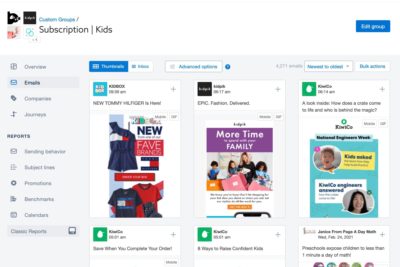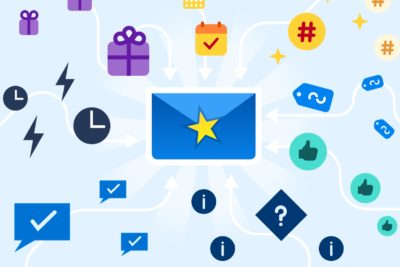Today, data makes the world go round.
The more information email marketers have, the easier it is to formulate strategies for winning abandoned-cart email campaigns. And, the more likely customers are going to engage with your emails.
It’s not enough for your emails to make it to the inbox. That’s just the first hurdle. What you need is a way to ratchet up customers’ interests. One way to do that is through personalization.
When asked in a survey to prioritize one capability that would be most important in the future, 33% of marketers responded with personalization.
Data opens up endless opportunities for deep personalization and reduces friction along the customer journey.
Pulling information and crafting personalized messages means your customers are going to see more than just an abandoned-cart email. It can let them know about price drops, loyalty rewards, related products, and local deals — all things that matter specifically to them.
The key is knowing where to look for the data you need. The good news: You’re probably sitting on it already.
Email service providers (ESP), customer relationship management (CRM) and loyalty management tools, and commerce platforms put a treasure trove of personalized data right at your fingertips.
Here are a few examples of emails that have tapped into data and embraced personalization.
Personalization + Sale Emails
Price Drop on the Items You Browsed
One of the best ways to dip into personalization is through customer behavior. Here, Hugo Boss uses browser history data from a commerce platform. The customer doesn’t even have to put the shoes in the cart; just browsing is enough. This way, the customer gets a note on a sale, not just in general — though that’s pretty nice too — but about the specific product they were interested in too.
Price drop: Nike React Element 87
Nike takes things even further with its personalization efforts. Again, using consumer browser data, they sent a sale notification email. Here, a few special features are added.
First, Nike puts the name of the product on sale right in the subject line, a simple way to personalize, but it’s an easy way to grab customer’s attention right away. Second, Nike offers product recommendations. Personalization plays a role here, too, because the products aren’t chosen randomly; they’re based on products related to the ones browsed.
Personalization + Abandoned-Cart Emails
Never postpone a ride
In this abandoned-cart email, just a little bit of data from an ESP can go a long way. You can’t get more personal than using someone’s name, and that’s here both in the email and the preview text.
The email also features an image of the specific product left in the cart versus a generic all-text email. La Passione also does something unique. It sends the email from Sara, an actual person in its customer experience department. Doing this is an easy way to provide peace of mind and make the message more customer-friendly. If the customer runs into an issue, they have a personal representative ready to help.
helen, We Have Saved Your Shopping Bag
Burberry’s email shows that just because the personalization is clean and simple, it doesn’t mean it’s not effective. Again, ESP data is used for the customer’s name. Burberry also uses the email to address two of the biggest reasons why consumers don’t complete a purchase: shipping issues and lack of help. Finally, using customer browser data, and possibly past purchase history as well, the email features two recommended products to entice the customer to add more to their cart.
Personalization + Product Recommendation Emails
Complete Your Look
Your customer’s journey never has to end at the sale — especially if you want them to buy again. Adidas uses ESP and browsing history data with commerce platform data in this email. Here, they use the information on what the customer already purchased to feature a specific set of related items that will help them “complete the look.” It tempts the customer with products that they likely are already interested in and make it really easy to buy. All they have to do is “click to pick” what they want.
Your next Shave Plan order is around the corner
Harry’s takes an already-personalized email, this one for a subscription box, and pulls in data to provide an even more customized experience. Beyond listing the product already ordered and in the box, it does a double set of featured product recommendations, all directly related to the blades. On top of that, the email also highlights a personalized referral link. It’s a great way to build customer interest. Who doesn’t like the idea of saving a few bucks? It’s also a nice, simple entry into a customer loyalty program, another place with plenty of data for personalization.
Personalization + Loyalty Emails
Jill, a new way to enjoy your Swarovski rewards
A loyalty program is another tool email marketers can use to mine all sorts of customer data. Even an email like this one from Swarovski, which is a name change announcement, has tons of personalized information within it.
To start, there’s data from the ESP, which includes the customer’s name. The email also mentions birthday rewards. From the commerce platform, the email can pull in data from past purchases, which ties directly into loyalty management systems, giving customers personalized information on everything from membership numbers to tier level and current spending. Geolocation API data can also tie into special VIP events in stores near where customers live.
As you can see, even small bits of customer data, when added to emails, can make a real difference to your customers. The more personalized you can get, the better for your customer (and you) over the long run.
If you want help activating the data you already have, you can check out the Zembula email personalization guide to get started. For additional personalized emails and inspiration, sign up for a free MailCharts account to start viewing email examples.
Liz Froment is a content writer at Zembula. A graduate of the University of Massachusetts at Amherst, Liz is a travel aficionado, Boston sports fan, and maple syrup connoisseur.
Editorial image by Free-Photos from Pixabay















